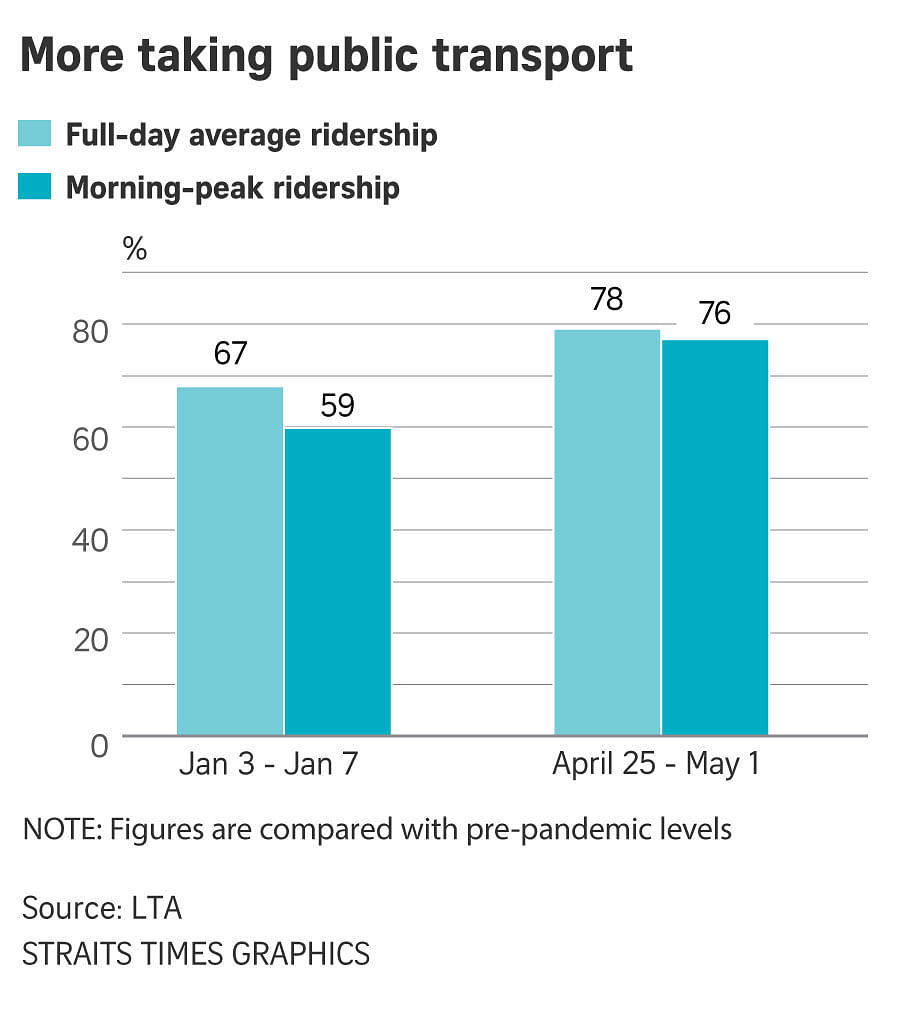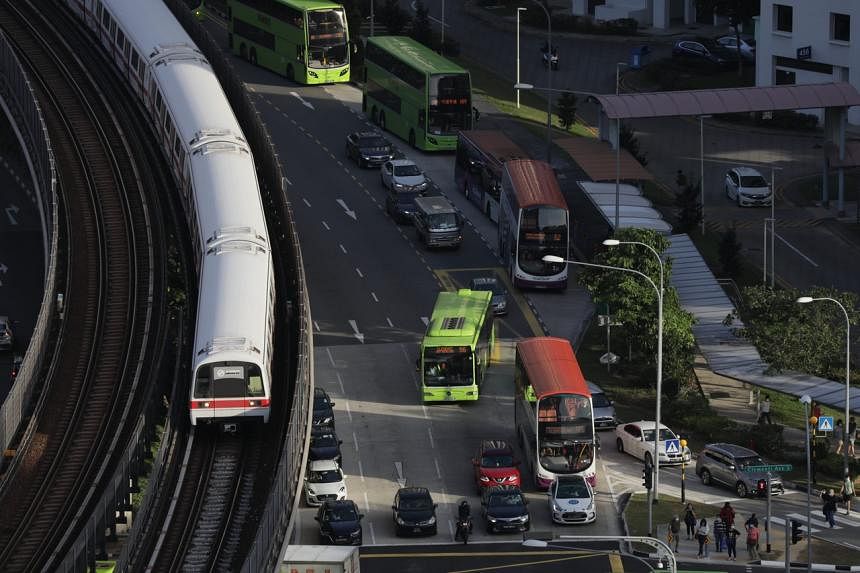SINGAPORE - Rail and bus ridership hit 78 per cent of pre-Covid-19 levels in the last week of April after Singapore dropped most of its pandemic restrictions, with all employees allowed to return to the workplace and group size limits removed.
This is a more than 10 percentage-point increase from the 67 per cent recorded in the first week of January, when group sizes were still capped at five and only up to 50 per cent of workers could go back to the office.
The latest figures from the Land Transport Authority (LTA) come as the broader Singapore economy reopens, with more people going to office, staying out late and in general, going out.
But a wholesale return to 2019 patterns remains some way off, LTA data showed.
While the number of commuters taking public transport during the morning peak also increased from 59 per cent of pre-pandemic levels to 76 per cent, those who tapped out at stations in the central business district during this time stayed at 51 per cent, in a sign that staggered working hours and telecommuting may be here to stay for a while yet.
“Seems like we are moving back to the pre-Covid-19 period,” Associate Professor Raymond Ong from the National University of Singapore said, when shown the latest figures.
“But (CBD) patterns seem to indicate that there might be some changes in office start times, perhaps more flexibility in the hours. If so, we will be expecting a change in post-pandemic travel patterns.
“This deserves a more careful look at how we design our public transport operations, including shorter frequency of trains and buses during the traditional off-peak hours.”
Public transport operators and the Government have said they are closely monitoring numbers to gauge if there will be a permanent shift in how people use public transport, with some observers also having forecast a semi-permanent drop in overall ridership.
The pandemic and Covid-19 restrictions have hit public transport ridership and fare revenue, with 2020 and 2021 the two years with the lowest ridership numbers since 2010.
For the 2020/2021 financial year, LTA posted a 30 per cent drop in fare revenue collected amid bus and rail ridership hovering at 60 per cent of what it was before the outbreak.
Madam Masayu Mansor, a 47-year-old officer in a local bank, said more vehicles on the roads now also mean bus journeys take longer.
She has to use a walking stick owing to physical disabilities, and said she has had difficulty getting a seat recently as all priority seats are usually occupied.
Security officer Mohd Hisham said trains are now more crowded and “a bit more uncomfortable” compared with the last two years. Waiting time, however, is still manageable, with an average wait of just two minutes for the train for him when he goes to work at 8.30am.

Separately, LTA said the number of people who took taxi and private-hire car services for the week of April 25 to May 1 remained at about 81 per cent of pre-Covid-19 levels, similar to the situation at the start of the year.
This is despite recent complaints of high surge fares and difficulties of getting a ride, as nightlife returns with alcohol sales after 10.30pm allowed from March 29 and nightclubs reopening on April 19.
The lack of cars can be partly explained by the number of taxis plying the roads continuing to drop this year, from 14,847 in January to 14,603 in March, down from 18,542 in 2019.
But LTA statistics also showed the number of taxi driver and private-hire car driver vocational licence holders inching up slightly from October last year to March, reversing the downward trend amid the pandemic that has led to a shrinkage of taxi and private-hire car fleet sizes.
There were 94,513 valid taxi driver’s vocational licence (TDVL) holders as at March, up from January’s 94,111.
For private-hire car driver’s vocational licence (PDVL), the figure was 48,300 in March, up from 47,913 in January.
Prof Ong said this small increase does not negate the fact that the industry lost about 7,000 TDVL holders and 8,000 PDVL holders amid the pandemic.
The taxi fleet has also shrunk from 18,500 in 2020 to 14,600 today, a drop that cannot be replaced quickly.
“We have had a 21 per cent reduction in taxi fleet, a 7 per cent drop in TDVL and a 14 per cent drop in PDVL. This increase in valid licence holders is still a short-term trend, although it seems that some drivers are seeing more normalcy as ridership improves,” he said.
Grab driver Anamullah Hamidullah, 63, said there are a lot more passengers now, although heavier traffic means he still does about the same number of trips each day.
“It is very easy to get passengers nowadays. Friday night, Saturday and Sunday are busier, but I still have to wait a bit in between passengers on weekdays,” he said.
- Additional reporting by Irdina Aisyah


